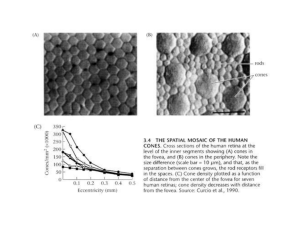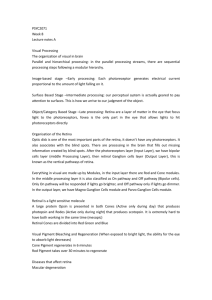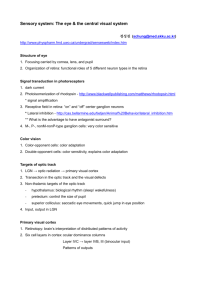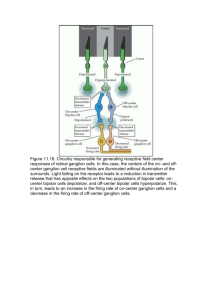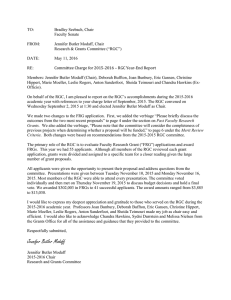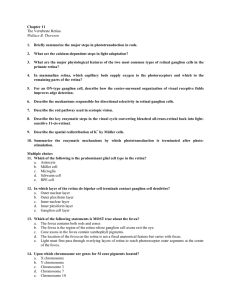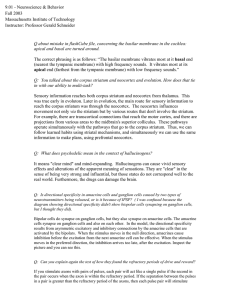powerpoint
advertisement
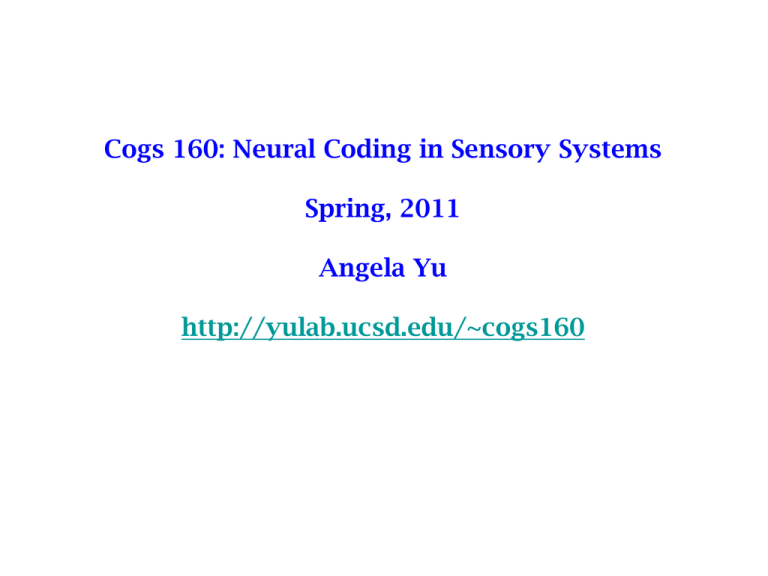
Cogs 160: Neural Coding in Sensory Systems Spring, 2011 Angela Yu http://yulab.ucsd.edu/~cogs160 Cell Types in the Retina Information Processing Cell Types in the Retina 50+ cell types, distinct in morphology Cell Types in the Retina Wiring specificity Circuit Diagram of the Retina Classical View of Retinal Ganglion Cells (RGC) ON-center/OFF-surround OFF-center/ON-surround Mach Band Detection of Dim Light • Photoreceptors hyperpolarizes, releases inhibition on bipolar cells • Rod bipolar pools over many rod photoreceptors • Band-pass temporal filter minimizes chemical noise • Thresholding (half-wave rectification) minimizes electrical & chemical noise Texture Motion • Y-type ganglion cells sensitive to motion (either direction) • Each shift excites some bipolars and inhibits others • Only active ones contribute, due to thresholding • Biphasic dynamics ⇒ transient response (why?) • Motion prediction: RGC true center (how do we know?) • Continuation when stimulus turns • RGC spatially extended, but no trailing edge (why?) Differential (Object) Motion • Object-motion-sensitive (OMS) ganglion cell is silent under global motion, active under local motion • Built like a Y cell in the center of RF, inhibited by amacrine cell respond to motion in the periphery • OMS activates only when center & surround activities mismatch in time and/or response level Approaching Motion • A type of RGC responds to approaching motion, and not lateral motion • Summing over many ON/OFF bipolar pairs, all thresholded • Leading & trailing edge cancel out in lateral motion • But only leading edge in approaching motion • Gap junction from ON bipolar to Amacrine (extra synpase) Spike Latency Encoding • Spike latency: dark: early, light: late, mixed: intermediate • ON pathway is slower Switching Circuit • OFF pathway normally dominant • After saccadic eye movement, ON pathway dominant • Mediated by amacrine cells • Dale’s Law • Why is switching circuit useful? • Decoding? Synaptic Depression & Pattern Adaptation • Synaptic depression due to vesicle depletion (seconds to recover) • B1 & B2 have same RF; A1, A2 inhibit presynaptically • Vertical stripes: B1/A1 asynchronous, strong response, depresses • B2/A2 synchronous, weak response, recovers from depression Linear Readout of Neural Computation • What does a neuron “compute”? • Authors suggest readout should be “easy”? • In particular, linear summation, e.g. summed by a dendritic tree • But dendritic response are known to be nonlinear • And where are x1, x2, ... stored in example? Discussion


